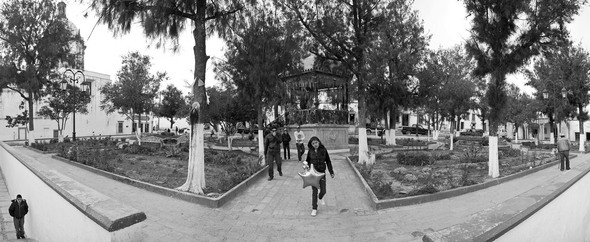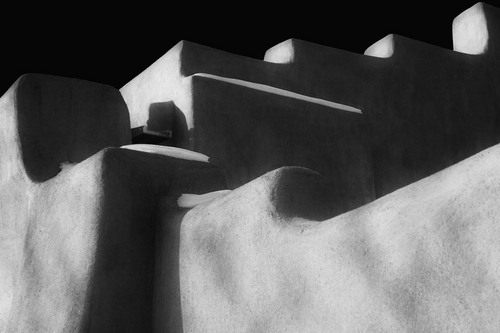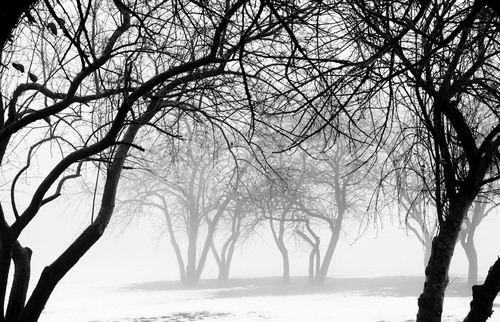Work of 3 artists at WSG Gallery shows enduring power of black and white photography

"Passing" by Dirk Bakker
“Photography in Black and White: Three Visions” at Ann Arbor’s WSG Gallery reminds us we may see the world in color, but black and white are the colors of our emotions. This show is one of those fascinating exhibitions illustrating a single artform’s ability to speak to us feven as it supposedly sits on the verge of aesthetic extinction. Forms of black and white photography date to the early 19th century. Ever since the advent of color photography, black and white has been predicted to be passé. Yet it persists and thrives.
Like analog sound in relation to digital recordings, black and white photography has found a niche in the art world that’s uniquely suited to its rarefied aesthetic. Accomplished artists find it challenging for the many psychological complexities it fosters. Perhaps color photography’s spectrum is too vivid to fully allow for psychological penetration and depth. Black and white photography, by contrast, works with infinite tonal gradations that restrict the artist’s palette, thereby allowing for specific emotional responses.
This is certainly the case of the three artists on display in WSG’s exhibit. Terry Abrams, Dirk Bakker, and Nina Hauser have each found differing uses for black and white photography that make the most of the art form while allowing each a unique perspective.
Dirk Bakker, a longtime photographer for the Detroit Institute of Arts, has the most journalistic eye of the trio. His three works in this display each tell a story. Each is highly accomplished—and each plays with the medium in its way—but all three are also ostensibly straightforward in their appearance and composition.
According to his gallery statement, “In two recent works, ‘Passing’ and ‘Theodice Denied’ (Bakker illustrates) the underlying theme of transient evil” through “a more historic form of the photographic medium, the absence of color.”
These two large-scale images; taken in Latin America, use wide-angle lenses to great effect in creating a narrative. “Passing” captures a young girl walking towards the camera, while the wide-angle of photograph crafts an artificial perspective that fixes her at the center of the expansive composition.“Theodice Denied” features the extraordinarily complex root structure of a tree seemingly crawling down an embankment.
Bakker’s third large-scale photo, “Fourth Elegy: Flowering and Fading Come to us both at Once” is also a full-scale drama. Made in collaboration with Chicago performance artist Sandra Binion, the photo is one of a series of Bakker interpretations drawn from Rainer Maria Rilke’s “Duino Elegies.” In this instance, a man holding a flashlight focuses his beam of light on the face of a surprised woman caught disrobing. The fine-grained mysterious nature of photograph is fraught with tension, surprise, and disclosure.
Nina Hauser’s 10 photographs in this exhibit play with the nature of photographic tonality within the context of landscape, architecture, and still-life genres. Working with both standard and infrared film stock, Hauser looks for the crevices in the ghostly intersection of light and dark.
“From portraits to landscapes,” says Hauser in her artist’s statement, “images are stepping stones that trace where the mind has been and reflect the unique vision each of us carries through life.”

"Ghost Ranch Adobe: Abiquiu, New Mexico" by Nina Hauser
The poetry of Hauser’s statement is well reflected in her “Contrasting Elements: Ponte del Este, Uruguay,” where distant landscape, furious coastline, and eye-catching cloud cover intermingle with such fine gradation, it takes a concentrated viewing to decide where one element ends and the other begins. The photograph’s majestic scale ultimately makes it obvious that the contrasting elements are really a complementary whole.
By comparison, Hauser’s masterwork in the exhibit, “Ghost Ranch Adobe, Abiquiu, New Mexico,” merges the tonalities of this adobe structure with such a fine eye that the angles of the adobe begin to indeed take on a ghostly appearance. Hauser’s sense of visual balance pivots the photograph expertly between foreground and relief in such a manner as to accent each curve of the abode structure.
Terry Abrams —Â whose work was shown earlier this year at Concordia University —depicts what he describes in his artist’s statement as “simple, atmospheric compositions in nature.” But this is far too modest for the effect he creates. It’s more telling that he adds, “Working in black and white permits me to concentrate on tonal values to produce an emotional quality generated by light, gesture, and contrast.”
This is more like it, because Abrams’ digital images printed on cottonwood paper are nothing less than stunning gradations of nature. Abrams’ “Perpetual Mountains, Death Valley” is a remarkable view of a mountain top whose half-dozen black and white grades shift in striking contrast through the work‘s visual recession.

"Celebration" by Terry Abrams
Abrams’ four tree studies in this exhibit (taken in Ann Arbor’s Buhr Park) carry this theme forward with stunning precision as well as equally stunning artistic concision. These works—“Structural Movement,” “Coming to Life,” “Performance,” and "Celebration”—are modulated wintry landscapes where a ground haze pulls the viewer’s eye into the background. As handsomely desolate as they are psychologically striking, Abrams’ tree portraits are everything one could imagine of such a subject.
“Photography in Black and White: Three Visions” will continue through May 8 at WSG Gallery, 306 S. Main St. Gallery hours are noon-6 p.m. Tuesday-Thursday; noon-9 p.m. Friday-Saturday; and noon-5 p.m. Sunday. For information, call 734-761-2287.

